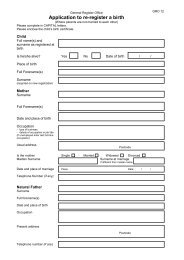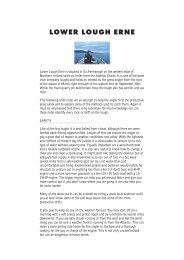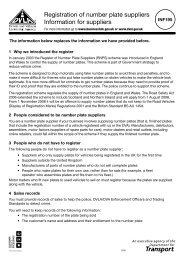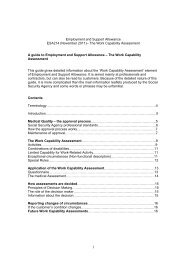an instructors guide to delivering compulsory basic training - NIDirect
an instructors guide to delivering compulsory basic training - NIDirect
an instructors guide to delivering compulsory basic training - NIDirect
Create successful ePaper yourself
Turn your PDF publications into a flip-book with our unique Google optimized e-Paper software.
2. CBT Syllabus<br />
You should demonstrate when appropriate the level of bal<strong>an</strong>ce, steering <strong>an</strong>d control<br />
needed for this exercise. Your pupils should be given the ch<strong>an</strong>ce <strong>to</strong> practise until<br />
they are confident of their ability.<br />
Basic skills – They need <strong>to</strong> be able <strong>to</strong> ride around in a U-turn <strong>an</strong>d be able <strong>to</strong><br />
coordinate <strong>an</strong>d control their:<br />
• bal<strong>an</strong>ce;<br />
• steering; <strong>an</strong>d<br />
• use of the clutch, throttle <strong>an</strong>d rear brake.<br />
In addition, your pupils need <strong>to</strong> underst<strong>an</strong>d when, how <strong>an</strong>d where <strong>to</strong> look for traffic<br />
or other hazards.<br />
They should try <strong>to</strong> avoid:<br />
• harsh use of the controls;<br />
• looking down;<br />
• not taking effective observation; <strong>an</strong>d<br />
• using their feet <strong>to</strong> help overcome poor bal<strong>an</strong>ce.<br />
Bring the mo<strong>to</strong>rcycle <strong>to</strong> a s<strong>to</strong>p under full control as in <strong>an</strong> emergency<br />
Your pupils must be able <strong>to</strong> s<strong>to</strong>p safely should <strong>an</strong> emergency arise. However, whilst<br />
emergencies c<strong>an</strong> <strong>an</strong>d do arise it is import<strong>an</strong>t <strong>to</strong> explain that having <strong>to</strong> carry out <strong>an</strong><br />
emergency s<strong>to</strong>p could signify a weakness in a rider’s pl<strong>an</strong>ning <strong>an</strong>d hazard awareness<br />
skills. If these skills are used properly it will help prevent a critical situation developing.<br />
You should explain the effects of applying the brakes individually <strong>an</strong>d using them<br />
<strong>to</strong>gether. This may then be followed by a demonstration <strong>to</strong> highlight some of the<br />
main points. Your pupils need <strong>to</strong> underst<strong>an</strong>d:<br />
• how weight is tr<strong>an</strong>sferred during heavy braking; <strong>an</strong>d<br />
• how weight tr<strong>an</strong>sfer c<strong>an</strong> affect the rear wheel.<br />
Reference may be made <strong>to</strong> using the brakes in the ratio 75% front <strong>an</strong>d 25% rear on<br />
a dry road surface <strong>an</strong>d 50% front <strong>an</strong>d 50% rear on a wet road surface. It is import<strong>an</strong>t<br />
that your pupils underst<strong>an</strong>d these percentages refers <strong>to</strong> braking force, not lever<br />
movement.<br />
35









